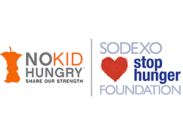Hunger is a serious and often hidden problem in America that affects 13 million kids every year.

Nearly 3 out of 4 teachers say they have children in their classrooms who regularly come to school hungry, according to a 2015 report by the national campaign No Kid Hungry. While 22 million households receive some form of reduced lunch, fewer than half of those kids eat in the morning. This means 200,000 school buses full of kids who aren’t filling up on breakfast each day!

It can be difficult to recognize hunger in your classroom, but there’s a good chance that it’s there. A lack of energy, low participation, irritability—these can all be signs of children being hungry, which definitely affects their ability to learn each day. It can feel overwhelming, but as an educator, there are ways you can help.
A SIGN OF SOMETHING MORE
Although many think the problem of food insecurity is most prevalent in urban areas, kids go hungry everywhere, including rural areas, suburbs, and outlying areas. Hunger affects 1 in 5 children in our county. And it can be a hidden issue that masks other problems in the classroom.

Teachers, administrators, nonprofits, and government officials are working together to find creative ways to feed children at school. These include breakfast, snacks, lunch, dinner and even take-home bags for the weekends. Educators are realizing that it’s hard for students to learn when their stomachs are growling, and we all have to work together to do something about it.
“When kids have to worry about food, it consumes them and their families,” says Lashawn Whitmore-Sells, principal at the Sustainability Academy, a K-5 public school in Burlington, Vermont. She finds hunger can hurt a child’s attendance, health, behavior, and ability to concentrate in class. So the school provides breakfast at 7:45 in the morning, healthy snacks, lunch, and even dinner, for those who stay for after-school programs. You can learn more about food security here.

The academy has over 50 percent of its students who quality for free and reduced meals, and so food is provided to everyone at no charge. “It’s a concerted effort to make sure kids have what they need and also for families to know that their child will come to school and be fed and taken care of,” says Whitmore-Sells.

The number of low-income children in public schools has steadily grown over the past several years and now an estimated 51 percent are living in poverty. This means more schools are feeding not only federally subsidized lunches, but also breakfasts and dinners.
THE HUGE VALUE OF BREAKFAST
Kids especially need food in the morning to kick start their day, but not all students take advantage of free school breakfast. While about 94 percent of client households served at Feeding America, a network of hunger relief organization, participate in the National School Lunch Program, only 46 percent report coming for the School Breakfast program. Check out the valuable school breakfast brochure from No Kid Hungry.
To help, some schools are being more flexible about when food is available to increase accessibility. For instance, there are programs that serve breakfast in the classroom. Another pilot in San Diego offers a portable breakfast for kids on food carts between first and second period.
“The nutrition break in the morning makes better sense, because students don’t always get to school early enough for breakfast,” says Emalyn Leppard, a teacher at Montgomery Middle School in San Diego for 20 years. Now, grabbing fresh fruit or a muffin off the cart is becoming a routine as they come to her second-period math class. The options are healthier than the usual chips or energy drink they used to consume.
“I see the impact of it right afterwards,” says Leppard. “It sends a message of support… ‘I’m hungry’ is not an issue.”
THE LONG-TERM EFFECTS OF HUNGER
About 93 percent of educators surveyed for the Hunger in Our Schools 2015 report say they are concerned about the long-term effects hunger could have on children’s education.

Research compiled by the Food Research and Action Center, a national nonprofit working to improve public policies and partnership to end hunger, shows how school breakfast can positively impact children’s health and learning. School breakfast has been linked with fewer visits to the school nurse, particularly in the morning. Children who eat breakfast at school, which is closer to class and test-taking time, perform better on standardized tests than those who skip breakfast or eat breakfast at home. Providing breakfast also improves their concentration, alertness, comprehension, memory, and learning.
“Teachers are on the front lines and are aware of kids being hungry,” says Jessie Hewins, senior child nutrition policy analyst with FRAC. The loss of instructional time, due to headaches and other symptoms of hunger, is real. Teachers can play an important role by making sure families know how to sign up for free and reduced meals at school and by pushing for innovative programs that provide food when it’s convenient for students, Hewins says.

Logistical changes necessary to accommodate serving food throughout the day include adding more trash cans and allowing extra time for set up and transitions. But advocates say the trade-off of having fueled kids is worth it.
About three-quarters of teachers with breakfast in the classroom say the program has been positive for their students because students have been fed, are energized, and no one is singled out, according to Hunger in Our Schools report.
Hannah Walker is an AmeriCorps volunteer with No Kid Hungry Washington, and she’s seen the positive effects breakfast can have on students first-hand. She had a high-energy student who used to have a hard time directing all of his energy, so she gave him a leadership role in helping run the breakfast program at the school.
“I’ve seen his behavior completely shift,” Walker says. “It starts him off the day in a good direction. He eats his breakfast then he keeps the clean-up station running in an orderly fashion. For him to be engaging in something positive gives him a positive sense of self.”
Get more information and learn about other nationwide efforts with breakfasts on the No Kid Hungry’s website.
HUNGER HITS EVERYWHERE
Hunger can be a problem even in affluent communities like Boulder, Colorado. Ann Cooper, director of food services for Boulder Valley School District, says the numbers of students who qualify for free and reduced lunch in the district has risen by about 30 percent over the last eight years. In a partnership with the YMCA, the district sends home about 300 bags of fresh groceries and healthy recipes with students in need to encourage families to cook on the weekends. The district is committed to using organic ingredients and everything is cooked from scratch, without corn syrup or highly processed foods.
“In Boulder, hunger is sort of a ghost issue,” says Cooper. “When we did an evaluation, one thing that came to light was how much hunger there is even in our community and how little is known about it.”
Burlington, Vermont, is home to five colleges, a large hospital, and a healthy tourism industry, but it also has a refugee resettlement area, and 56 percent of kids qualify for free and reduced meals. Schools play an important role in the health of the community, says Doug Davis, director of food service in Burlington public schools. Davis suggests schools not think of serving meals as a hindrance, but rather focus on the positive impact proper nutrition can have on learning.
“We all have to recognize we are here for the same reason, and if people feel the kids making a mess is an impediment to what we are doing, they are in the wrong business,” Davis says. “The kids are the customers and we need to serve them as best we can.”


